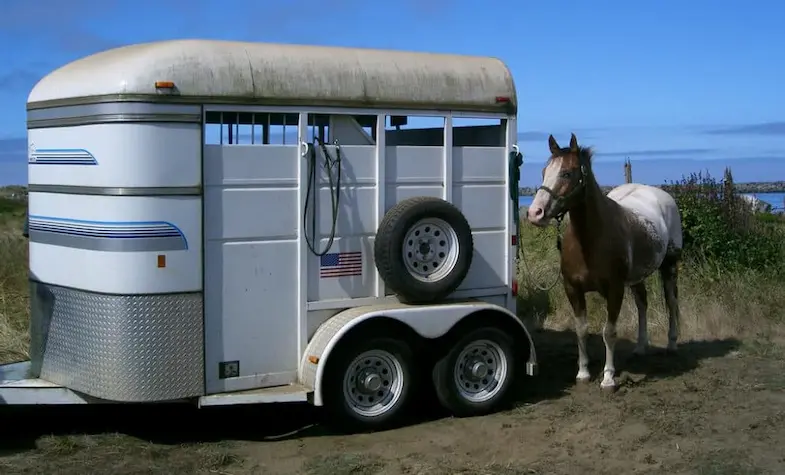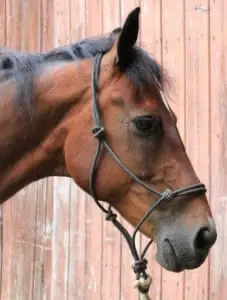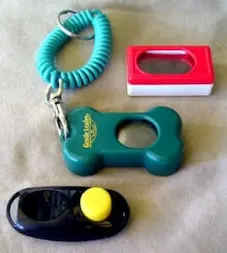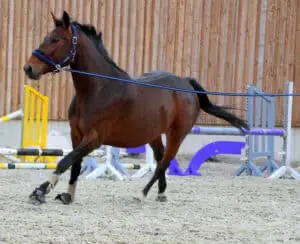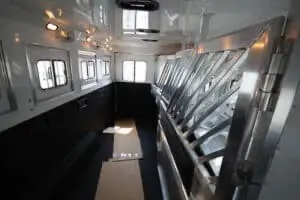You might not be a frequent attendee at shows or events but that doesn’t mean you don’t need to load your horse from time to time, you may have to make an emergency visit to the veterinarian, your circumstances may change and you need to move your horse or you may just want a change of scenery and fancy riding in a new location. Whatever the reason it’s important to be prepared and that your horse safely loads and unloads, training your horse beforehand will not only minimize his stress but it will also make your life easier too.
There may be plenty of people that say you should push your horse into the trailer from behind and yes this may work at getting him into the trailer, but he certainly won’t be happy there and will be eager to get out the second you lower the ramp. Instead, it’s far better to work with your horse and show him that there’s nothing to be scared of about the trailer, yes it’s dark but that doesn’t automatically mean it’s bad. I find it always helps to put yourself in your horse’s shoes (or his hooves at least) and ask how you’d feel if you were asked to go into a dark place without knowing if it was safe or if there was a predator waiting for you. If you understand what’s going through his mind then it’s the first step towards getting him to comfortably walk into the trailer when you ask (and happily stay there).
Why won’t my horse load?
Horses can be very anxious and tense about loading for a number of reasons and if you’re getting frustrated with his desire to stay outside of the trailer you could unwittingly be making his behavior worse. Horses are herd animals so automatically want to follow us and please us but they also have to trust that we won’t let them come to any harm, but if you’re shouting at your horse and trying to push him into the trailer he’ll only become more anxious and will refuse even more so trying to stay calm is crucial.
Generally, the cause of a horse not loading is either down to some sort of fear or confusion, or in some cases both:
- Scared – Horses are fight or flight animals so their instinct is to either run from the perceived threat or just go nowhere near it. To your horse, a trailer is a dark, confined place that doesn’t have anywhere to hide.
- Bad experience – Horses that have had a bad experience with trailers in the past (such as a stressful journey or an accident) can develop a fear of loading that they didn’t have before. This can also happen if you get annoyed with your horse when he won’t go into the trailer easily, he won’t understand why you are annoyed but will link it with his negative thoughts about being inside the trailer.
- Mixed signals – When loading a horse, and especially when training a new horse to load, it’s imperative to give clear and easily understandable signals. Horses read our body language a lot more than they listen to the words (and tone) we’re using so if you talk to your horse with a gentle voice but look him straight in the eye he’ll just be confused. He’ll take this as a negative action if he’s already nervous because it can be a sign of dominance rather than affection.
Training methods for loading a horse
Every horse is different and what works well for one horse won’t necessarily work well for another which is why I thought it was better to talk about a few training methods but, before you start (and regardless of which method you opt for), there’s a few things that you need to make sure of beforehand.
- Make sure the trailer is hitched up to a vehicle and is on safe ground – even the lightest of horses can way enough to move an unhitched trailer so this is essential. It’s also important to make sure the ground is level and safe so that if your horse decides to throw himself to the floor he won’t get hurt, sand is ideal.
- If you can have the trailer facing your horse’s stall or his friends – this will help him feel as if he’s heading towards a friendly environment rather than moving away from it. This won’t work with all horses, but if your horse cries when he’s separated from his friends then it will definitely help.
- Stay safe yourself – when a horse is frightened they won’t always consider their owner or handler so it’s important that you use a long lead line so that you can quickly jump out of your horse’s way if he panics and tries to jump off of the ramp or rushes backward out of the trailer.
- Never get angry with your horse, no matter how frustrated you are – remember that your horse is already anxious and is looking to you for reassurance, if you start to get annoyed with him he’ll resist you and your commands even more. Also, there’s no point getting into an argument with a horse, they’re much bigger and stronger so you won’t win.
- Don’t turn your horse away from the ramp, even if it makes your life harder – often when your horse turns away from the trailer he’s playing for time so that he can delay having to get into it. While you might think it’ll be easier to quickly turn him around so that he’s facing the trailer again, in his mind he’s found a tactic that means he won’t need to get into the trailer. Your horse needs to know that it doesn’t matter how awkwardly he positions himself he’s still going in.
- Be persistent and don’t give up until your horse is in the trailer – even if you have a five minute break your horse will see this as a victory in his battle with the trailer. He’ll then just become even more stubborn because he’ll know that this means you’ll give up. Instead, you need to persist until he’s inside, no matter how long it takes I’m afraid.
- Make it easy for your horse to do the right thing – a horse isn’t refusing to go into the trailer for fun, he genuinely thinks that he’s better off staying outside but if you make it more unpleasant for him to be outside he’ll quickly learn that doing what you want him to do is the best option. You don’t need to rant and rave at him, just calming show him it’s better.
- Once your horse is in the trailer don’t stop, repeat – once your horse is safely inside it’s good practice to reward him then repeat the process a few times. I know this might sound cruel but you’re actually building on the positive experience and reaffirming to your horse that there’s nothing to be afraid of.
- Don’t forget about unloading your horse too – while unloading is normally easier you need to also teach your horse to wait patiently inside the trailer until you tell him he’s okay to leave and make sure that he does it safely and quietly, without running out as fast as he can.
Using positive reinforcement training to load a difficult horse
Horses are intelligent animals and will learn far quicker if you reward good or positive behavior instead of punishing bad or negative behavior which is why this method of training works so well and, if done properly, leads to a happy horse.
The idea is simple, you ignore anything your horse does wrong but reward him (whether by praising him, offering him a treat or by just releasing the pressure) when he does something good. There are different ways to positively train your horse and I’ve talked about two of them below.
Pressure or Dually halter
A pressure or Dually halter works by making the horse accountable for it actions, if they back away from where you want them to be the halter applies pressure mainly to the nose (but also a little bit on the poll). The horse learns to step forward to release the pressure and subsequently is rewarded for doing the right thing. When your horse understands how the halter works you can begin training him to load into the trailer.
To do this use a long lead line and stand on the ramp to encourage your horse to walk up, don’t look your horse directly in the eye while you’re doing this, he’ll see that as a negative sign. Instead, be patient, and if he backs away just stand your ground, releasing the pressure as soon as he steps forward.
I know it might sound like I’ve oversimplified this method but if your horse has been trained to understand how the halter works it really is that easy.
IMPORTANT: The halter is a training aid and as such should NEVER be used to tie a horse up, even for a few minutes. If he pulls back then he’ll be met with continuous pressure which could panic him and result in serious injury.
Clicker reward
This is very similar to the pressure halter method but relies on the use of a clicker and an edible reward when the horse does the right thing instead of the release of pressure. Again you’ll need to train your horse to respond to the clicker first and associate that with doing the correct thing.
To start with, train your horse with very simple tasks that you know he’ll probably get right pretty quickly, making sure every time he does what you ask him to do you use the clicker and give him a treat. Once he’s learned to associate the two you can start to train him to go into the trailer.
Once you’ve successfully loaded your horse into the trailer give him a few treats and praise him, allow him to relax for a few minutes before asking him to calmly step forward. After he’s taken a few steps forward user the clicker and reward again before continuing to unload him.
How to use touch target training to load a horse
This can be time consuming to start with because you need to teach your horse that in order to get a treat he needs to touch an object (or marker) first. It doesn’t matter what the object is that you use but to begin with just show it to your horse and when he stretches forward to sniff it praise him, as soon as he touches the object with his nose though give him a treat. Once he’s learned how to get the treat, step away from him and encourage him to walk forward and touch the object again, rewarding him when he does.
In time your horse will learn to follow the object and that is when you can start to begin training him to load calmly, although to some extent it’s even more crucial that you take this stage slowly and don’t expect your horse to just follow you into the trailer. When you first start doing this get your horse to put a foot on the ramp then stop there and praise him. When he’s relaxed ask him to put both of his front feet on (or all four if he’s okay with that) before stopping again. Once your horse has all four feet on the trailer ask him to follow you inside, making sure he can see you at all times.
Behavior adjustment training for loading a horse
With this method, the handler is reading the horse’s body language and reacting to it immediately. It works because the horse feels that they’re in control and that the handler is listening to them, this puts them at ease and makes them more willing to do something they wouldn’t normally feel comfortable doing.
Using a long lead line begin to walk your horse towards the trailer, constantly watching him for the slightest indication of anxiety or tension, and stop the second you see any signs. When your horse starts to relax apply a little bit of pressure to the lead line so that he walks closer to the trailer. Every time your horse displays any sign of tension stop and wait for him to relax before continuing again. By not putting any unnecessary pressure on your horse you’re showing him that it’s okay to trust you and that you understand his language.
How to make the trailer a comfortable environment for your horse
Once your horse is loaded into the trailer you need to make it a comfortable place for him to be before setting off on your journey. There are a number of changes you can make to the trailer itself, such as removing partitions (if possible) to make it feel more spacious and making sure windows are clean and open to give more light and fresh air, you should also turn on any lights that the trailer has.
Aside from the changes you make to the trailer you can also make the interior more inviting by using a lavender spray or oil and installing a horse safe mirror. The lavender will help to keep your horse calm and relaxed while the mirror will make him think that there’s another horse there and he’s not on his own.
Shop the article
If you want to buy any of the items I mention in the article I’ve included links below to them on Amazon.
Further reading
- Transporting horses overseas
- Improve your horse’s confidence
- Calming an anxious horse
- Bonding with your horse
- How horses show affection
- Desensitizing horses to fireworks
- Prevent loneliness is horses
- Understanding horse body language
I hope you found this article helpful. If you did I’d be grateful if you could share it please as it would really help me.
Recommended products
Over the years I have tried hundreds of different horsey products, from various blankets and halters to different treats. Some I’ve loved, others I’ve hated but I thought I’d share with you my top all-time favorite products, the ones I never leave the yard without. I’ve included links to the products (which are in no particular order) that I really think are great.
- Horse Knots by Reference Ready – If you’re like me and enjoy pocket reference guides then you’ll love this knot tying guide. These handy cards can easily fit in your pocket or attach to the saddle for quick reference. They’re waterproof, durable and are color coded to make them easy to follow.
- Mane ’n Tail Detangler – Even if you never show your horse you’ll need to detangle his tail from time to time (and possibly his mane too) which is always a challenging chore! I’ve found that if I run a little bit of detangler through my horse’s tails every few days it stops them from getting matted up and makes combing them easy, even if they’re coated in mud. I don’t know if I should admit to this or not but it also works wonders on my hair.
- TAKEKIT Pro clippers – Over the years I’ve tried a lot of different clippers and while some were obviously better than others I found these to be by far the best. They are heavier than a lot of other clippers but for me, that’s a good thing, it makes them feel more sturdy and hardwearing. On top of that they have a range of speeds so are just as good for clipping your horse’s back as they are his face. I also like the fact that they come in a handy carry case but that’s not for everybody. The company that makes them is super good and incredibly helpful too, a real bonus these days. The only thing I wasn’t keen on was the fact that it doesn’t come with any oil, but that’s not a major problem as it’s not difficult to buy lubricant.
- Shire’s ball feeder – There are so many boredom buster toys out there but I like to use these every day, regardless of whether or not my horses are bored. I find that it helps to encourage my horses to problem solve by rewarding them with treats (or pieces of fruit) but it also mimics their natural grazing behavior which helps to keep them calm and de-stressed.
- Horse safe mirror – This is a strange one that many people are surprised about but I like to put horse safe mirrors in the trailers as well as in the quarantine stalls. It helps to prevent the feeling of isolation by giving the impression of other horses being around. Being herd animals horses can get extremely stressed when they feel that they’re on their own but with these stick-on mirrors, they believe that at least one other horse is with them.
- Rectal thermometer – I know this isn’t glamourous at all but it’s vital for your horse’s well-being to be able to check their temperature and a rectal thermometer is the easiest way of doing this which is why I’ve added it to the list.
Shopping lists
I’ve also put together a few shopping lists of essential items that I’ve found helpful over the years. I’ve broken the lists down into different categories rather than put everything in one massive list 😉

